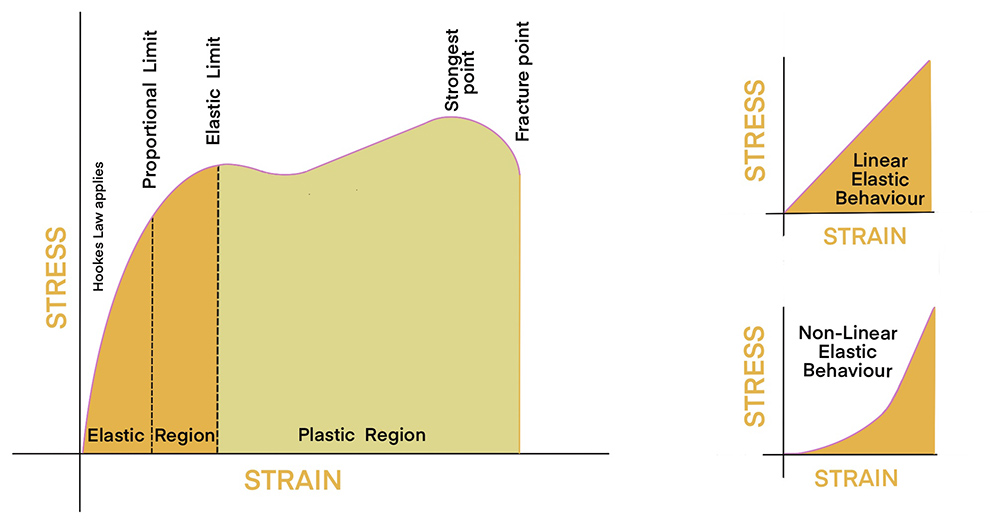Elastic limit
Contents |
[edit] Introduction
All materials show elastic behaviour to a degree, some more than others. If, after a load has been applied and then quickly removed, a material returns rapidly to its original shape, it is said to be behaving elastically. Elasticity is a crucial characteristic of building materials; if it were not, buildings would suffer continuous deformation under load and ultimately would collapse.
[edit] Elastic limit
A solid material’s elastic limit is the maximum stress per unit area it can withstand before there is permanent deformation. In other words, it is the limit of the material’s elasticity, for up to that point, the solid can resume its original shape when the load is removed; after that point, it undergoes permanent (plastic) deformation and will not return to its original shape even after the load (yield load) has been removed.
On a graph showing a stress-strain curve, the point of the limit of elastic behaviour is called the ‘yield point’ and this is where plastic deformation begins – some of this deformation will be plastic and irreversible. In structural engineering, the yield point is regarded as a ‘soft failure’ mode which does not usually cause catastrophic or ultimate failure. It might be referred to as the fracture point or in the case of structural failure the breaking point, such as where a timber beam goes beyond, the yield, soft failure and fracture to break and collapse.
No structural material exhibits perfect elasticity: depending on the type of structure and the material, permanent deformations are unavoidable whenever loads exceed certain values. That is why engineers design structures to ensure the materials are being used within their elastic range and the loads involved will not produce permanent deformations.
All structural materials behave plastically beyond their elastic range. However, even if some materials show elastic behaviour, they may – after a long period of service, usually many years – exhibit a degree of plastic flow (or creep).
[edit] Linear elasticity
This occurs when the deformation in a material is proportional to the load applied. So, if a person weighing 50kg causes a diving board to deflect by 300mm, and another person weighing 100kg causes an identical board to deflect by 600mm, the diving board is exhibiting linear deflection. Most structural materials are, within limits, linearly elastic and are used within their linearly elastic range.
[edit] Related articles on Designing Buildings
- Concept structural design.
- Detailed design.
- Elements of structure in buildings.
- Moment.
- Stiffness.
- Structural engineer.
- Structural principles.
- Structural systems for offices.
- Structural vibration.
- Structures at the end of their design life.
- The development of structural membranes.
- Types of structural load.
- Vibrations.
Featured articles and news
Infrastructure that connect the physical and digital domains.
Harnessing robotics and AI in challenging environments
The key to nuclear decommissioning and fusion engineering.
BSRIA announces Lisa Ashworth as new CEO
Tasked with furthering BSRIA’s impressive growth ambitions.
Public buildings get half a million energy efficiency boost
£557 million to switch to cleaner heating and save on energy.
CIOB launches pre-election manifesto
Outlining potential future policies for the next government.
Grenfell Tower Inquiry announcement
Phase 2 hearings come to a close and the final report due in September.
Progress from Parts L, F and O: A whitepaper, one year on.
A replicated study to understand the opinion of practitioners.
ECA announces new president 2024
Electrical engineer and business leader Stuart Smith.
A distinct type of countryside that should be celebrated.
Should Part O be extended to existing buildings?
EAC brands heatwave adaptation a missed opportunity.
Definition of Statutory in workplace and facilities management
Established by IWFM, BESA, CIBSE and BSRIA.
Tackling the transition from traditional heating systems
59% lack the necessary information and confidence to switch.
The general election and the construction industry
As PM, Rishi Sunak announces July 4 date for an election.
Eco apprenticeships continue help grow green workforce
A year after being recognised at the King's coronation.
Permitted development rights for agricultural buildings
The changes coming into effect as of May 21, 2024.






















